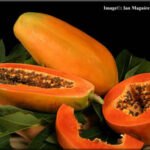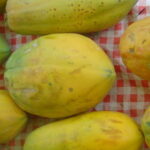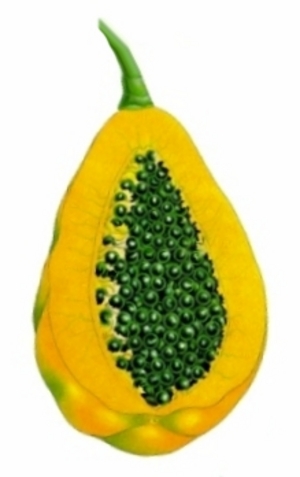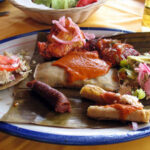My favorite produce rack is the mark-down table at the grocery. My meal plans sort of evolve from whatever I find on sale. The savings are usually significant and the losses from spoilage minor if you eat the fruits and vegetables without too much delay.
Yesterday I encountered two red, spiny lumps, each about the size of my fist, labeled Dragon Fruit. I had no idea what they were. They cost $1.33, more than a marked down papaya or pepper, but hey, they looked interesting. Who can resist a dragon?
So they came home with me. Here is what I have learned. Dragon Fruit comes from dry, tropical climates, and grows on a cactus-like tree. Its genus is Hylocereus, and it is also called Pitaya. There are three main types: Red, Costa Rica, and Yellow. Red is the most common, and that is the kind that I bought.
Red Pitaya has red skin and white fruit. Costa Rica Pitaya has red skin and red fruit. Yellow Pitaya has red skin and yellow fruit. All are a good source of vitamin C, fiber and phosphorus, and are low in calories.
So I proceeded to cut my dragon in two. I discovered that I had purchased a Red Pitaya. Remember that I got these from the discount rack. One of the fruits had a spot that was beginning to spoil, so I cut that away and learned that the good flesh is white to gray-white, and it turns to darker gray as it ripens to the point of being bad. The flesh is sprinkled with small dark seeds, reminiscent of kiwi, but the seeds appear throughout the fruit in a random pattern. The skin is thick as compared with an apple or pear, but not like the rind of a citrus fruit, and peeled easily.
When I tasted the fruit the texture was also a lot like kiwi, but the taste is sweet and smooth, not sharp like kiwi. The flesh is soft when fully ripe- similar to ripe pear. I put some chunks on my morning yogurt along with a tart plum. My hubby is not an adventurous eater, but I got him to try a piece. He also thought that the texture was like a pear, leading him to decide that he wouldn’t like to eat one plain, but that it would be ok if it were in something else.
I would suggest that this would be good to eat both plain, and to combine with other fruits in salad. It would also be an attractive garnish, with or without the skin. I think that eating it cold would taste best.
To eat it plain you could cut it in wedges in the skin, and serve like wedges of citrus fruit or melon where you pick it up with your fingers and eat the flesh out of the rind. You could also just cut it in half and eat the flesh out of the rind with a spoon.
When I make fruit salads I often like to combine tart flavors with smoother ones. Banana is high on my list of fruits that provide that smooth sweetness. But I think that Red Dragon Fruit would serve this purpose well too.
As a garnish the speckled chunks provide visual interest, and slices with the rind are very attractive.
The seeds are not digestible. Pitaya, especially the Costa Rican one with red fruit may turn urine or feces reddish, similar to eating beets, so don’t be alarmed!
If I have a chance to try the other varieties I won’t hesitate. My first encounter with the dragon has been a good one.





